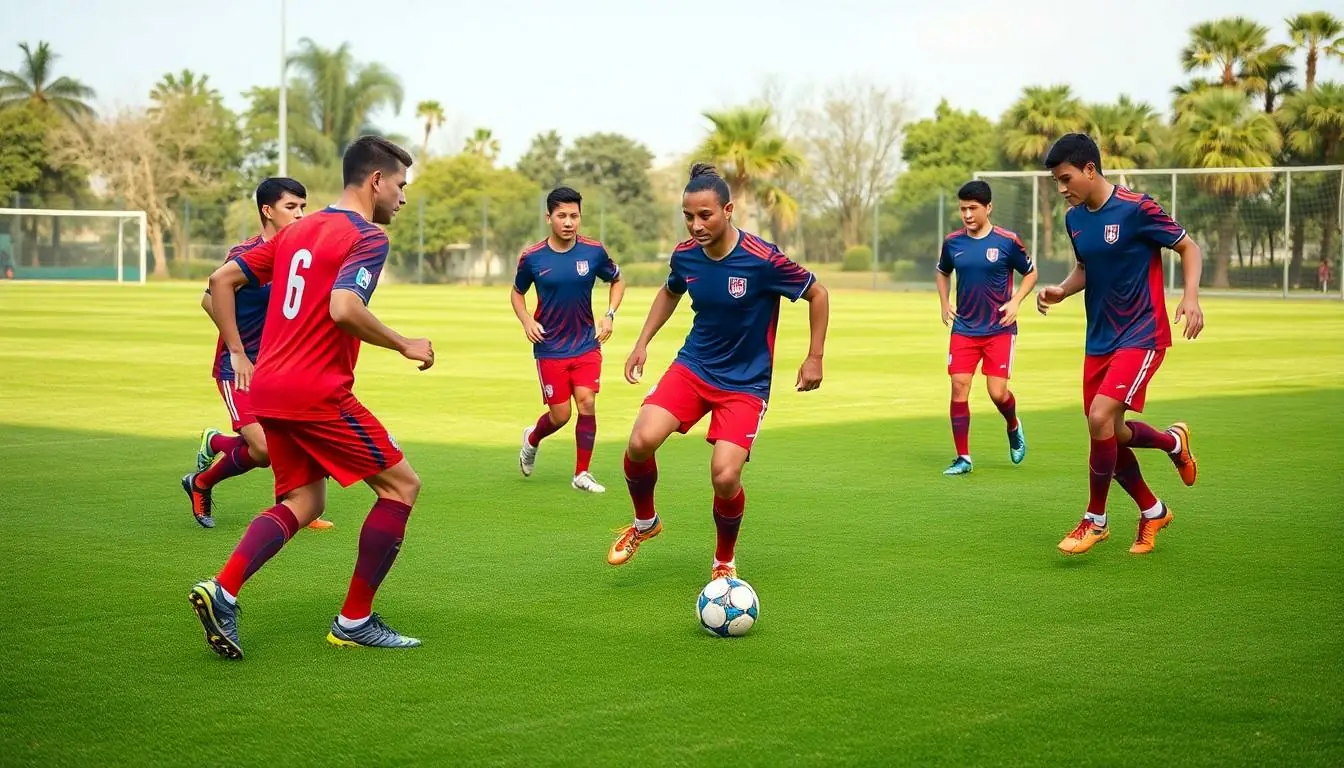Table of Contents
ToggleWhen it comes to soccer, nothing stirs excitement quite like a FIFA friendly match. These games may not carry the weight of a World Cup final, but they pack a punch in terms of entertainment and strategy. Picture your favorite players showcasing their skills, testing new tactics, and maybe even pulling off a cheeky nutmeg or two. It’s like a rehearsal dinner before the big wedding—fun, relaxed, and a chance to see what’s in store.
Overview of Amistosos FIFA
FIFA friendly matches serve an important role in international soccer. These matches provide teams with opportunities to test their skills and build cohesion among players. Coaches often utilize these games to evaluate talent, implement strategies, and foster team chemistry.
Rosters for these matches may include a mix of seasoned veterans and emerging players. Each friendly allows players to gain valuable experience against various styles and tactics from global opponents. Strategies evolve as coaches experiment with formations and player combinations in real scenarios.
Competitive environments during friendlies can still attract significant interest. Fans often rally to support their national teams, creating an electrifying atmosphere. Despite the games not contributing to official rankings, fans experience moments of joy and anticipation.
Scheduling for amistosos can vary, with matches frequently occurring in international breaks. Teams often take advantage of this time to compete against diverse opponents, enhancing their readiness for future competitive fixtures.
Data from recent years shows the growing popularity of friendly matches among nations. Countries increasingly prioritize these opportunities to strengthen bonds, showcase talent, and engage fans across continents.
Although not high-stakes like tournament matches, amistosos provide essential platforms for growth. Players shine under pressure, displaying their skills and ambitions that may lead to future squad selections. Development and preparation remain critical aspects of the global soccer landscape amidst the friendly environment.
Importance of Amistosos FIFA
FIFA friendly matches play a crucial role in shaping international soccer teams. They provide platforms for skill testing and team bonding, enabling national squads to prepare for competitive events.
Benefits for National Teams
National teams benefit significantly from amistosos. Coaches assess players in various formations, which helps refine tactics. Competitive environments against diverse opponents promote adaptability and flexibility. Furthermore, these matches allow coaches to build chemistry among teammates. Roster experimentation occurs frequently, mixing seasoned players with newcomers to gauge synergy. Many teams use amistosos to strengthen global relationships, fostering sports diplomacy.
Impact on Player Development
Player development thrives through participation in amistosos. Young talents gain firsthand experience against high-caliber opponents, enhancing their skills. Exposure to different playing styles broadens tactical understanding and improves decision-making. Regular opportunities for trial and error lead to growth in confidence. Coaches provide specific feedback during these matches, contributing to individual player improvement. Overall, friendly matches serve as vital stepping stones in a player’s career journey.
Recent Trends in Amistosos FIFA
Recent years show a marked increase in the popularity of FIFA friendly matches. Countries prioritize these matches to enhance team readiness and showcase player talent. Fans eagerly attend these events, creating vibrant atmospheres. Data indicates a surge in attendance figures, with some matches drawing thousands of spectators. Streaming platforms and social media further amplify interest, allowing fans to engage with games globally. Countries like Brazil and Spain emphasize these matches, often scheduling high-profile friendly encounters.
Changes in scheduling also reflect evolving trends among FIFA amistosos. Matches frequently occur during international breaks, allowing teams to compete against diverse opponents. Adjustments in scheduling provide teams more flexibility while facilitating preparation for upcoming competitions. For example, coordinated friendlies often occur in clusters, maximizing exposure to different playing styles. Additionally, top teams increasingly seek matches against emerging soccer nations. This strategy enables established teams to gauge their talents against various tactics, fostering competitiveness and camaraderie on and off the pitch.
Notable Amistosos FIFA Matches
FIFA friendly matches feature some unforgettable moments in soccer history. These occasions highlight pivotal interactions and performances that resonate across generations.
Historical Matches
Historic encuentros often shape the trajectory of national teams. For instance, the 1999 match between Brazil and the Netherlands showcased skill and creativity, resulting in a thrilling 3-3 draw. In more recent history, the 2018 friendly between England and Spain ended with Spain’s 2-1 victory, demonstrating tactical prowess and adaptability. Such encounters not only foster competitive spirit but also serve as benchmarks for future tournaments. Teams use these matches to understand each other’s playing styles, leading to memorable and impactful results.
Memorable Performances
Individual brilliance comes to the forefront during friendly matches. Lionel Messi’s stunning hat-trick against Brazil in a 2016 amistoso exemplifies top-tier talent on display. Similarly, Cristiano Ronaldo’s performance against Argentina in 2014, where he scored a late equalizer, left a lasting impression. Young talents also shine in these games, as seen during U.S. Men’s National Team friendly matches where emerging players like Weston McKennie demonstrate their potential against formidable opponents. Such moments not only entertain fans but also underscore the evolving nature of international soccer.
Future of Amistosos FIFA
Amistosos FIFA are poised for continued relevance in international soccer. With teams increasingly depending on these matches to refine skills, the demand for strategic friendlies remains high. Data confirms a rising interest, as fans flock to stadiums and engage with broadcasts, showing the growing cultural significance of these encounters.
Emerging trends indicate a shift in scheduling practices, enabling teams to experiment with tactics more freely during international breaks. Opportunities for countries to test newer players alongside veterans are becoming more common, ensuring that rosters stay dynamic and adaptable. Soccer federations are recognizing the importance of these encounters, often prioritizing high-profile, competitive matchups.
Player development is a focal point of future amistosos. Young athletes thrive in environments where they can face off against established stars, gaining invaluable experience. As teams look to showcase their emerging talents, friendly matches offer platforms for these players to shine under pressure.
Expect to see an increase in strategic collaborations between teams from different regions. Countries are likely to engage in tightly coordinated friendlies, enabling them to learn from one another’s playing styles. The focus will shift towards maximizing exposure to varied tactics, preparing teams for future competitive fixtures.
Technology plays a vital role in how amicable matches are experienced. Streaming platforms enhance global accessibility, allowing fans to support their teams from afar. With social media amplifying the excitement, the engagement surrounding amistosos could surpass previous years, solidifying their place in the landscape of international soccer.
Conclusion
FIFA friendly matches play a vital role in the landscape of international soccer. They provide teams with the chance to refine their skills and build essential chemistry among players. As the popularity of these matches continues to grow fans are treated to thrilling encounters that showcase both emerging talent and seasoned veterans.
With evolving strategies and increased collaboration between teams from diverse regions amistosos are set to remain a key component in player development. The integration of technology enhances accessibility and engagement making these matches not just practice but a celebrated part of the soccer calendar. Ultimately amistosos contribute significantly to the preparation and evolution of the game on a global scale.






